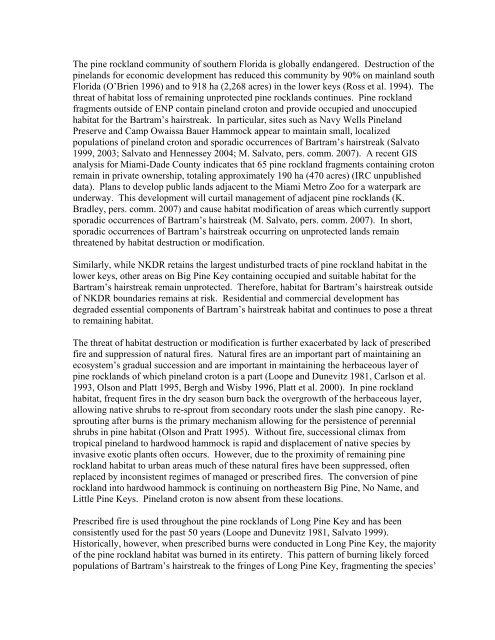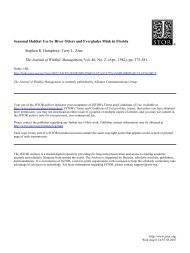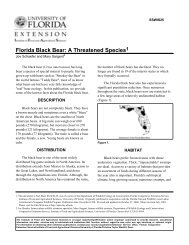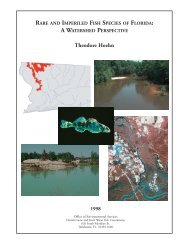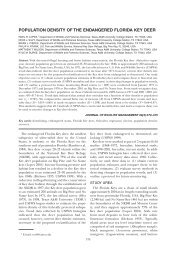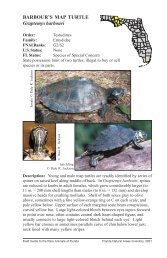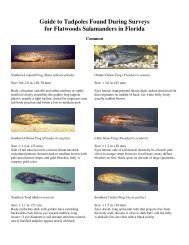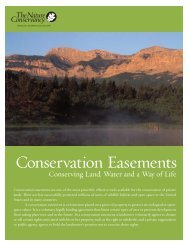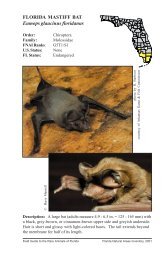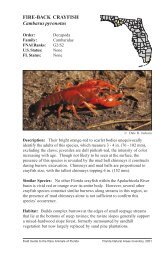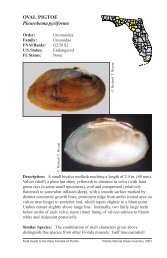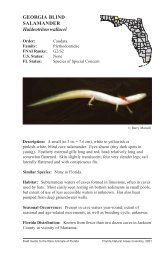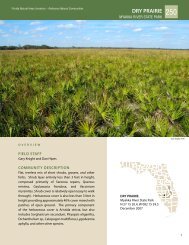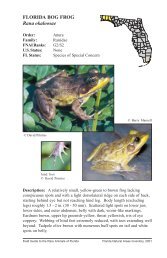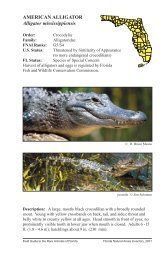Bartram's hairstreak butterfly - Florida Wildlife Conservation Guide
Bartram's hairstreak butterfly - Florida Wildlife Conservation Guide
Bartram's hairstreak butterfly - Florida Wildlife Conservation Guide
Create successful ePaper yourself
Turn your PDF publications into a flip-book with our unique Google optimized e-Paper software.
The pine rockland community of southern <strong>Florida</strong> is globally endangered. Destruction of the<br />
pinelands for economic development has reduced this community by 90% on mainland south<br />
<strong>Florida</strong> (O’Brien 1996) and to 918 ha (2,268 acres) in the lower keys (Ross et al. 1994). The<br />
threat of habitat loss of remaining unprotected pine rocklands continues. Pine rockland<br />
fragments outside of ENP contain pineland croton and provide occupied and unoccupied<br />
habitat for the Bartram’s <strong>hairstreak</strong>. In particular, sites such as Navy Wells Pineland<br />
Preserve and Camp Owaissa Bauer Hammock appear to maintain small, localized<br />
populations of pineland croton and sporadic occurrences of Bartram’s <strong>hairstreak</strong> (Salvato<br />
1999, 2003; Salvato and Hennessey 2004; M. Salvato, pers. comm. 2007). A recent GIS<br />
analysis for Miami-Dade County indicates that 65 pine rockland fragments containing croton<br />
remain in private ownership, totaling approximately 190 ha (470 acres) (IRC unpublished<br />
data). Plans to develop public lands adjacent to the Miami Metro Zoo for a waterpark are<br />
underway. This development will curtail management of adjacent pine rocklands (K.<br />
Bradley, pers. comm. 2007) and cause habitat modification of areas which currently support<br />
sporadic occurrences of Bartram’s <strong>hairstreak</strong> (M. Salvato, pers. comm. 2007). In short,<br />
sporadic occurrences of Bartram’s <strong>hairstreak</strong> occurring on unprotected lands remain<br />
threatened by habitat destruction or modification.<br />
Similarly, while NKDR retains the largest undisturbed tracts of pine rockland habitat in the<br />
lower keys, other areas on Big Pine Key containing occupied and suitable habitat for the<br />
Bartram’s <strong>hairstreak</strong> remain unprotected. Therefore, habitat for Bartram’s <strong>hairstreak</strong> outside<br />
of NKDR boundaries remains at risk. Residential and commercial development has<br />
degraded essential components of Bartram’s <strong>hairstreak</strong> habitat and continues to pose a threat<br />
to remaining habitat.<br />
The threat of habitat destruction or modification is further exacerbated by lack of prescribed<br />
fire and suppression of natural fires. Natural fires are an important part of maintaining an<br />
ecosystem’s gradual succession and are important in maintaining the herbaceous layer of<br />
pine rocklands of which pineland croton is a part (Loope and Dunevitz 1981, Carlson et al.<br />
1993, Olson and Platt 1995, Bergh and Wisby 1996, Platt et al. 2000). In pine rockland<br />
habitat, frequent fires in the dry season burn back the overgrowth of the herbaceous layer,<br />
allowing native shrubs to re-sprout from secondary roots under the slash pine canopy. Resprouting<br />
after burns is the primary mechanism allowing for the persistence of perennial<br />
shrubs in pine habitat (Olson and Pratt 1995). Without fire, successional climax from<br />
tropical pineland to hardwood hammock is rapid and displacement of native species by<br />
invasive exotic plants often occurs. However, due to the proximity of remaining pine<br />
rockland habitat to urban areas much of these natural fires have been suppressed, often<br />
replaced by inconsistent regimes of managed or prescribed fires. The conversion of pine<br />
rockland into hardwood hammock is continuing on northeastern Big Pine, No Name, and<br />
Little Pine Keys. Pineland croton is now absent from these locations.<br />
Prescribed fire is used throughout the pine rocklands of Long Pine Key and has been<br />
consistently used for the past 50 years (Loope and Dunevitz 1981, Salvato 1999).<br />
Historically, however, when prescribed burns were conducted in Long Pine Key, the majority<br />
of the pine rockland habitat was burned in its entirety. This pattern of burning likely forced<br />
populations of Bartram’s <strong>hairstreak</strong> to the fringes of Long Pine Key, fragmenting the species’


